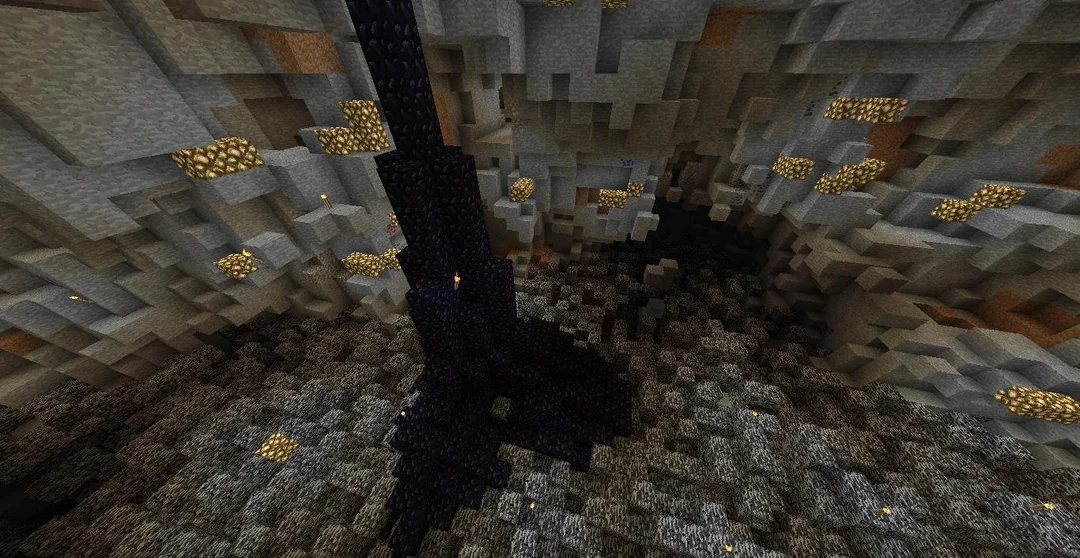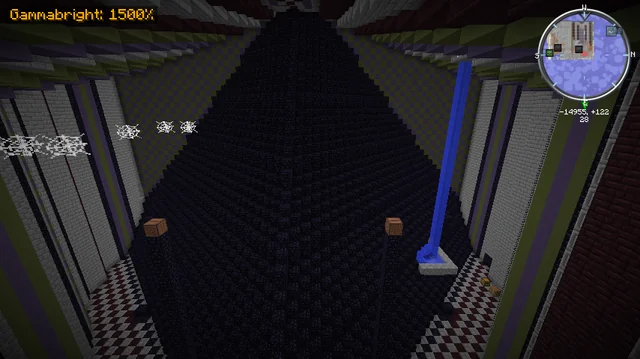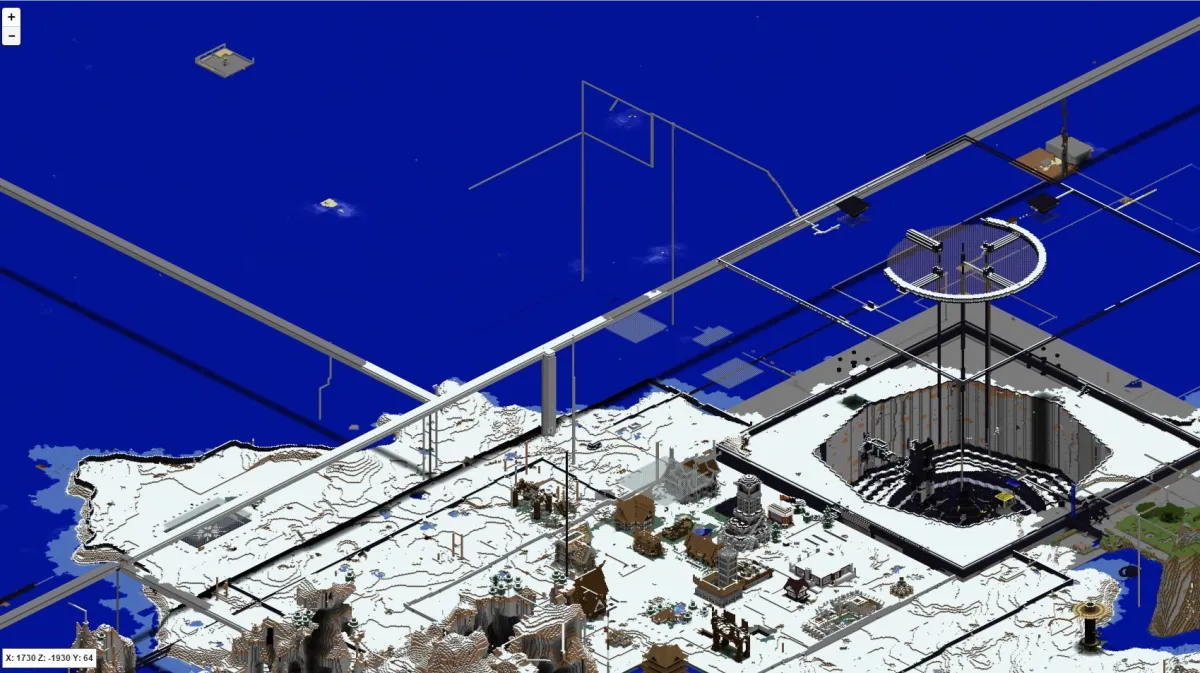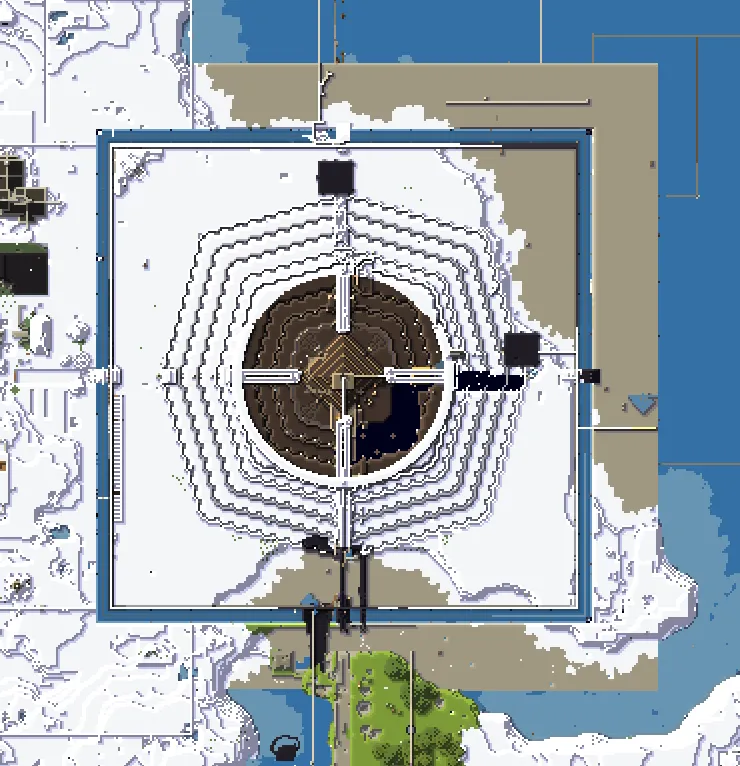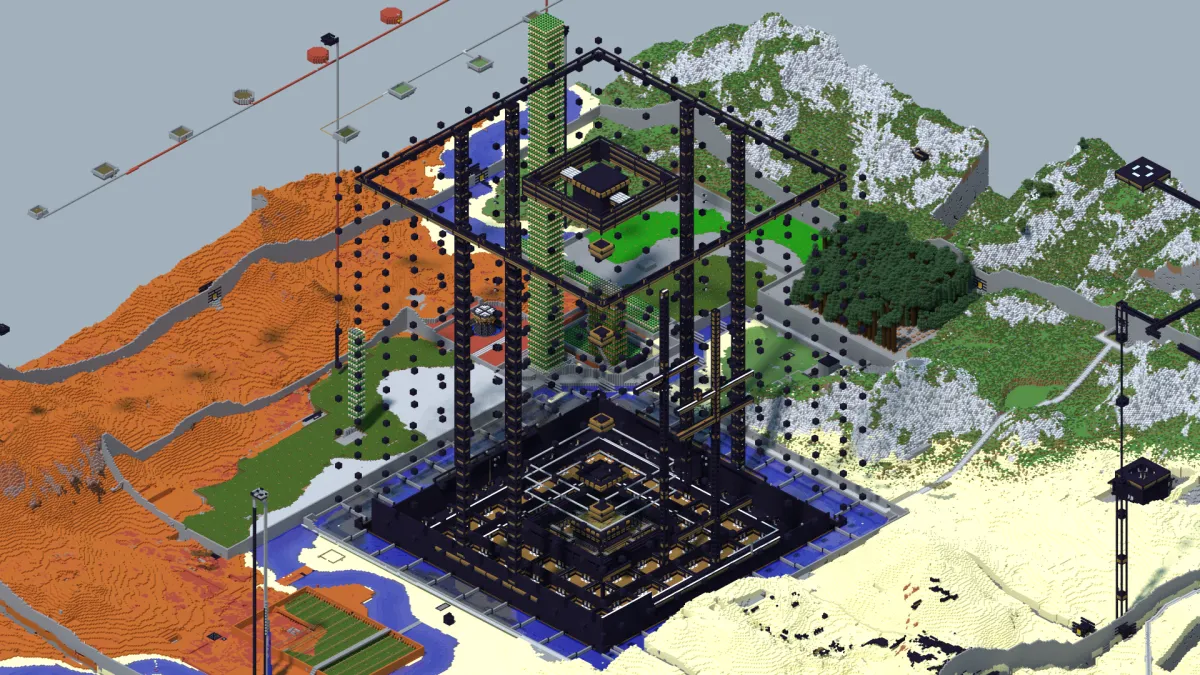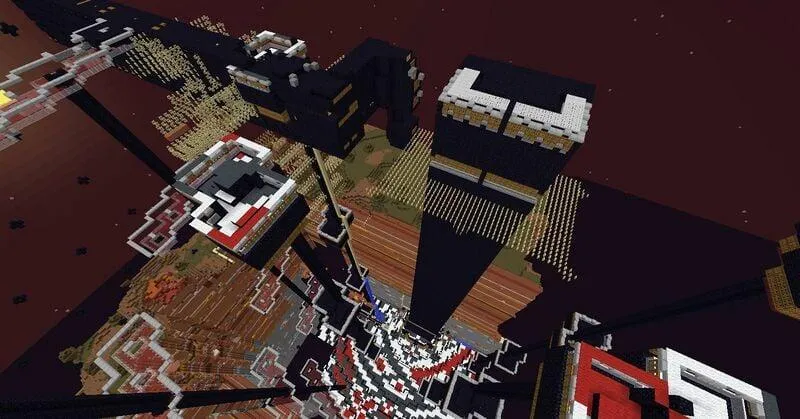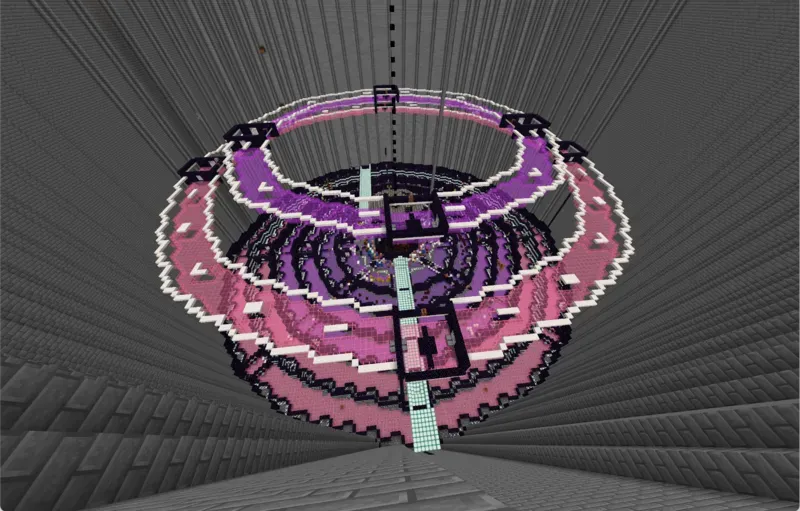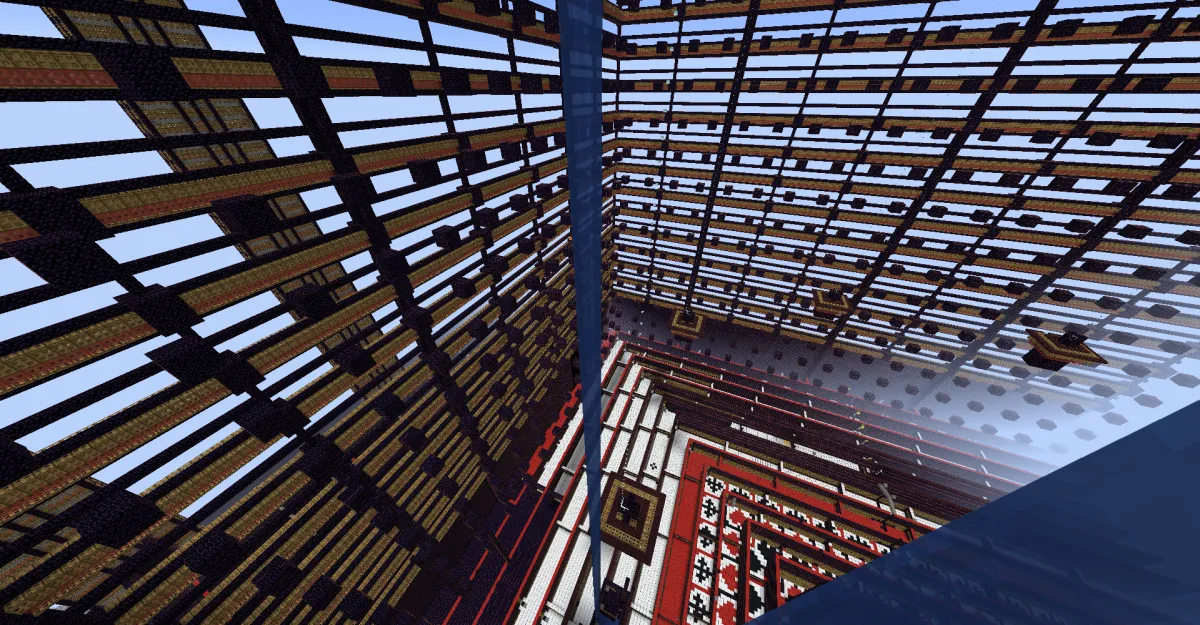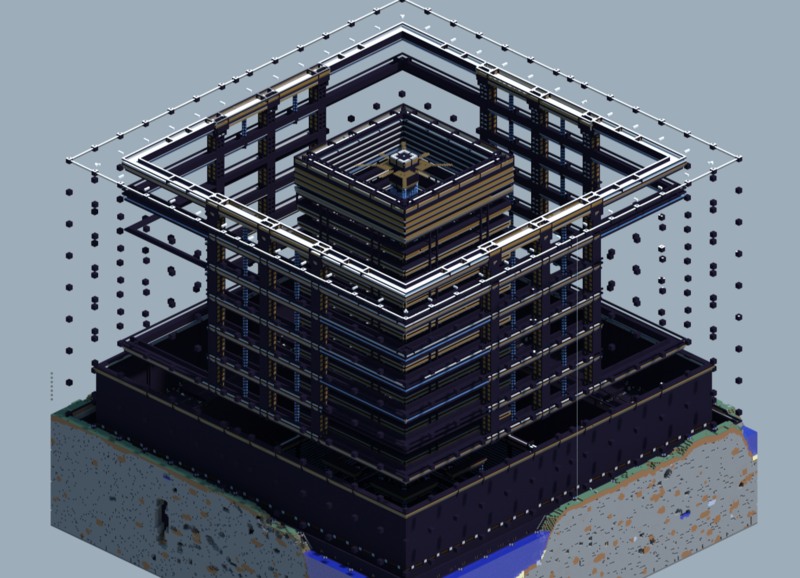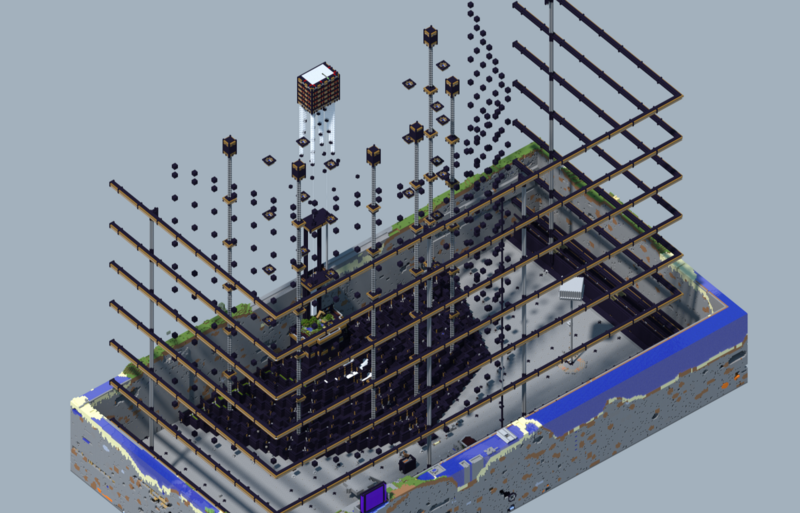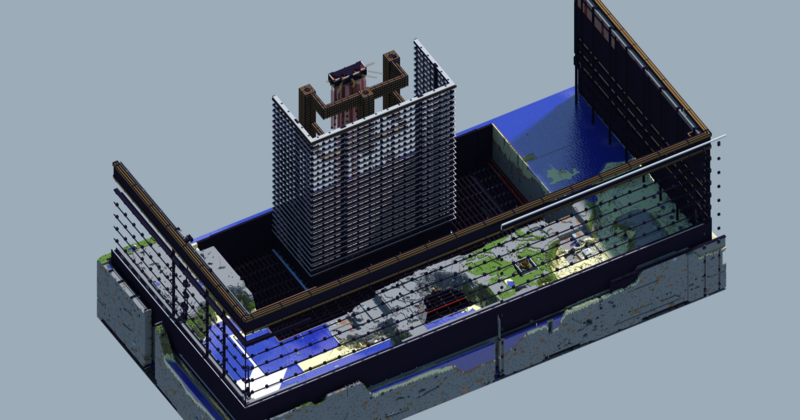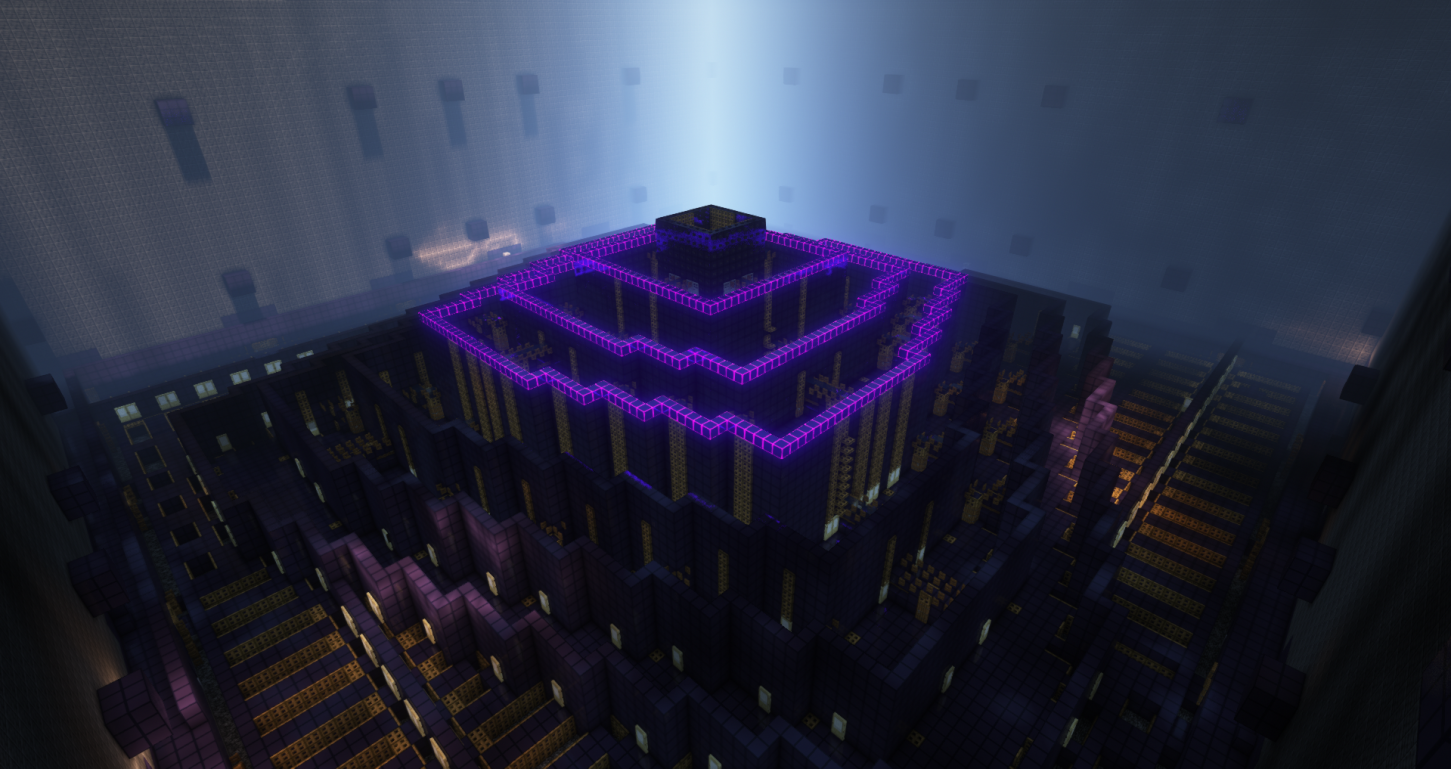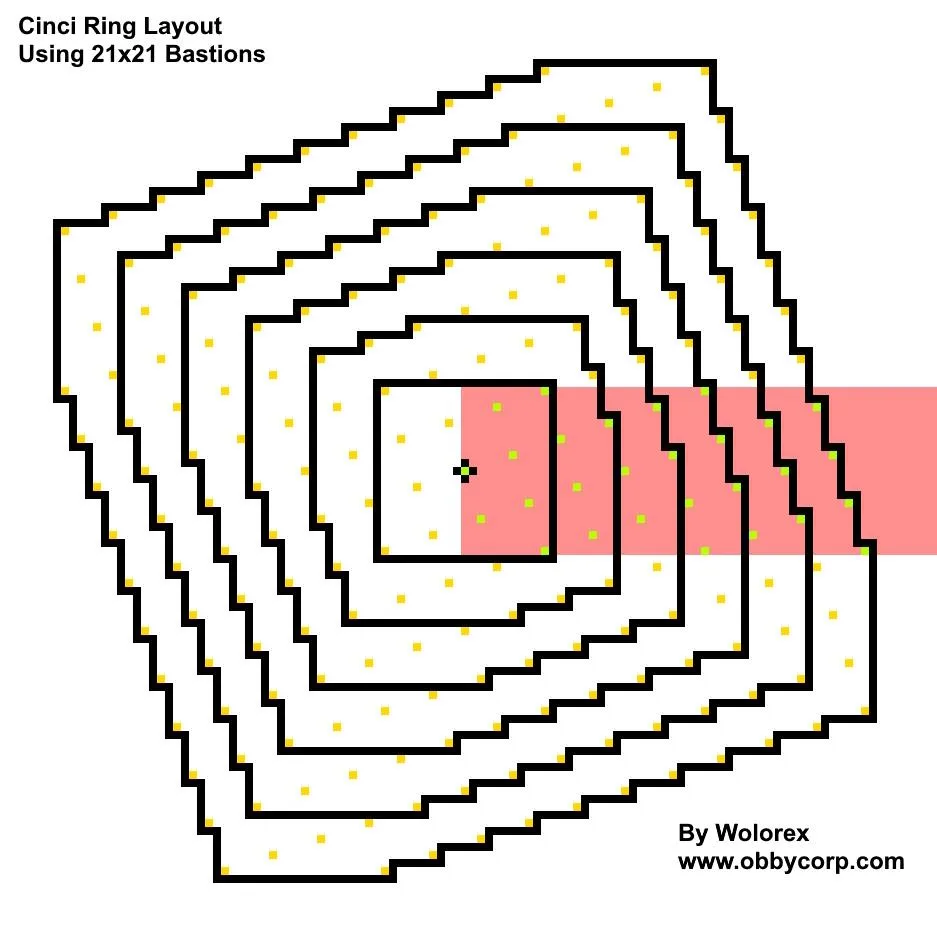
The History Of Vault Science
In the complex and highly competitive world of Civ servers, vaults represent the pinnacle of defensive engineering. These massive player-built fortresses are designed to hold prison pearls, protect resources, and serve as strongholds during wartime. The evolution of vault technology is a mirror of the arms race between defenders and attackers, shaped by plugin mechanics, player ingenuity, and constantly shifting metas. This page provides a comprehensive look into the various stages of vault design, explaining what each structure is, how it works, and how it evolved to counter new threats and meet emerging challenges. While this page aims to be readable and accessible to new players, it also serves as a deep strategic guide for veterans interested in understanding the roots and reasoning behind modern vault science.
Enjoy!
Chapter 1: The Original "Vault Science"
The Obsidian Pyramid Era
Vault Science began in Civcraft 1.0 and 2.0. In these early days, the term "Vault" referred to large pyramids made entirely of diamond reinforced obsidian (DRO), at bedrock level. These vaults were built before the addition of bastion mechanics; therefore the use of ground rings, archer rings, sky bridging, etc. were pointless, but also hadn't even been invented yet!
At the time, the only real defensive strategy was Vault Mass and Debuff Pvp. "Vault Science" began as the research of trying to find the optimal slope ratio for the DRO pyramid, the original 1:1 slope design was functional, but weaker to attacks from the top because the break path was shorter, so the idea was to make every possible angle of approach take as long as possible to mine through, thereby forcing attackers to commit substantial time, without needlessly wasting resources. Defenders would place prison pearls in the center chest, protected by thousands of diamond reinforced obsidian blocks, and rely on the sheer grind required to breach the center of the vault to deter any serious assault.
This era of vault science is marked by slope optimization, where players would calculate the ideal pyramid dimensions to ensure all attack vectors took the maximum amount of time. This was defense through inconvenience, not complexity. These original vaults arose during the first HCF invasions. Players would quickly start to utilize the world border in their designs, cutting costs in half, and creating the first "World Border Vaults". A common meta for Vault Science at the time was the 5:6 slope because it was the most effective and convenient slope ratio that anyone could copy without requiring an overabundance of math.
A common crime with this type of vault involved insiders who had full access to the pyramid, dismantling it and stealing all the diamonds from the reinforcements. To prevent this, vault owners began creating "spike" groups, which were stair-shaped DRO pathways placed on a different name-layer group than the rest of the vault. This allowed teammates to access the vault chest without risking the entire pyramid being stolen.
Today, pyramids are nearly obsolete. Most newer vault designers skip DRO chest reinforcement entirely, opting instead to just place pearls in a chest located in their central ground or sky bunker. The main reason pyramids are still used in modern vaults is to stop insiders from secretly freeing pearls. These new pyramids are much smaller, typically only 4 to 8 layers thick, and are sometimes only reinforced with iron. The addition of plugins such as "elevators" and "castle gate" in later editions have also allowed defenders to reach their central chest without breaking into their own vault and resetting the reinforcement's maturation, and removing the need for a spike group.
A vault in Civcraft 1.0 with an intricate design surrounding it, and a glass roof; a stark difference to the obsidian monoliths we see today.
View Original Post>
A very obscure slope shape in Civcraft 1.0; the possibility of attackers drilling from an angle was obviously an oversight.
View Original Post>
A very large world border vault found after the end of Civcraft 2.0
View Original Post>
Players seen breaking a vault at the end of the Recharge War in Civcraft 2.0
View Original Post>
Titan vault in Civcraft 2.0 with its perfectly circular rings and very strange overhead structure.
View Original Post>
The Kingdom of Nox, and their megavault. (2015)
View Original Post>
An example the "Nerd Ring" concept, using a circular bastion with a radius of 9 blocks. Placing obsidian on the outside of the bastion area; forcing players to mine through the walls or lean over them to place break within the bastion area. (The bastion in the middle would most likely be surrounded by DRO)
Introduction of Bastions and the Rise of Rings
The introduction of bastions in Civcraft 2.0 marked a radical transformation in vault design. Bastions created anti-place fields that prevented enemies from placing blocks within their radius, forcing attackers to break the bastion first before they could build or bomb effectively. Bastions could be broken by either mining the bastion itself, or by attempting to place blocks within the bastion's radius for an extended amount of time, called "Place Breaking". Around late 2014, players placed the first defensive rings of obsidian within these bastion fields, they were circular in shape, surrounding the vault and creating layers from the inside out, but they were not aligned with bastion boundaries and therefore weak to place breaking, like the rings used in Titan Vault. In 2015, players developed what would become "Flower Rings" or "Nerd Rings" (named after TealNerd), which were obsidian walls lined perfectly against the outward facing edges of the bastion field to maximize anti-place coverage around the vault, and force players to drill through a ring before being able to place break the bastion. Rings were a massive leap forward for all vault designs, turning them from lumps of obsidian into tools used by defenders to effectively combat attackers even when out numbered.
Two primary bastion layout strategies emerged across Civcraft 2.0 and Civcraft 3.0. The first was Nerd Rings, previously mentioned, a circular arrangement designed to layer rings of bastions with walls along their outside edges. The second was "Cola Cubes" (named after Diet_Cola), a more compartmentalized layout where bastions were placed in a grid layout, and all sides of the bastion were outlined in obsidian. Nerd Rings were conventionally more efficient in maximizing break time over a smaller area but risked losing multiple bastions at once. Cola Cubes were safer in terms of bastion loss but more expensive due to the size of the cubes, and inefficient in design and the needed resources to match the bastion break time of nerd rings. Nerd rings would come to be the dominate design choice used across CivCraft, Devoted, and CivClassics; later evolving into "Cinci Rings" (more about Cinci Rings in "SchizoTech & The Bastionless Revolution") before the last year of CivClassics and the beginning of CivUniverse launch. Cola Cubes became virtually obsolete for modern civ mechanics, though they made a brief comeback in CivRealms 2.0.
Traps have been common place across all Civcraft history, as well as spanning into HCF and many other similar servers. The original "traps" in these ringed vaults were commonly cobwebs lining the bottom of the walls of the vault rings, and archers could knock player back into these cobwebs and shoot them to death from the safety of their central bunker. However, defenders quickly realized that cobwebs were also a threat their own team when fighting inside the vault rings, and most modern vaults instead opt for the use of foot grinders instead (more about foot grinders in "The Skybridge Crisis")
Another advancement is "Trenches", which have became common for all vaults. They are deep holes dug from surface to bedrock surrounding the vault, and are filled with water and traps, creating a lethal border that defenders could navigate safely but attackers could not.
Such large, and advanced ringed vaults were considered unbreakable and would become known as "supervaults" or "megavaults" in the community. This mindset would hold true for a long time, until the fall of the Nox towards the end of Civcraft 2.0.
The First Central Ground Bunkers & Sky Bunkers
The first concept of central ground bunkers and sky bunkers began to appear near the end of Civcraft 2.0, often situated above or near the pyramid. While not yet optimized, these bunkers provided elevation, and cover for defenders, allowing them to effectively shoot attackers while staying safe in the middle of their vault, foreshadowing the critical role of bunkers and archery points in future vaults.
At the very begging of the introduction of bastions, some vaults were built underwater, a design nicknamed the "Fish Tank." The water served to slow down attackers by preventing efficient breaking and placing. However, Fish Tanks quickly became obsolete as ring vaults proved more robust and adaptable.
"All mega vaults have nerd rings. Do you think anyone who isn't a massive fuckin' nerd could build one of those?" ~ AllenY
A top down view of Nox, notice the flower shape of the rings that ripple out from the middle.
View Original Post>
A picture from inside Nox at the end of the siege; notice the cobwebs lining the inside of the rings.
View Original Post>
Chapter 2: The Skybridge Crisis
The Skybridge Meta
With the invention of "Skybridging", attackers found a way to circumvent ground-based bastion rings. By building a sky height bridge over a vault, attackers can safely place-break bastions from above and then descend into the vault area and obby bomb rings once bastions fell. This tactic minimized the need to dig through ground rings or navigate trenches. In response, defenders had to adapt rapidly.
Skybridging fundamentally changed the defensive landscape. It rendered large sections of traditional vault design obsolete, particularly for vaults that relied solely on ground rings for protection. To counter this, defenders developed a suite of sky-based defenses. "Snitch curtains" were one of the first advancements, expanding snitch coverage across the entire vertical space around the vault, ensuring visibility of attackers at any height.
Archer Pods, Archer Rings, and the Electric Fence
The first serious sky defense structures were Archer Pods. These small sky bunkers were scattered around the vault and designed for archers to fire upon attackers. While effective in the hands of skilled defenders, they were isolated and limited in coverage. The next evolution was the Archer Ring, a large sky-high ring structure that followed the bastion edge layout. Unlike isolated pods, Archer Rings allowed coordinated defender movement and broader fields of fire.
Eventually, players developed the Electric Fence concept, a stacked series of Archer Rings extending from bedrock to sky limit. This vertical wall of defense made it almost impossible for attackers to bridge at any height without being exposed to defensive fire. Electric Fences were extremely effective in deterring skybridges, but they were extremely costly and time-consuming to build. Moreover, if attackers breached the fence in a single location, the entire structure could quickly become compromised.
Despite these innovations, skybridging remains dominant due to its safety and simplicity. It continues to force defenders to rethink the fundamentals of vault design even today.
Bunkers and Utility Centralization
As vaults grew more complex, the need for centralized infrastructure increased. Ground bunkers became standard during the Devoted period. These bunkers, often built around or above the pyramid, serve as logistical hubs. They house factories, storage, and spawn points for defenders. While the central pyramids slowly continue to become less critical, the ground bunker has become an important feature for vault designs.
Sky bunkers, used initially for archery, also evolved into multifunctional fallback zones. In some vaults, the sky bunker became a secondary vault core, especially useful if the ground was compromised. Whether in the sky or underground, the centralized bunker became the anchor point for defenders, both strategically and logistically.
Lexington Vault from early CivClassics; a very large skybridge (left) was used to quickly and safely break the bastions of Lexington, while also providing attackers a semi-safe position to fire at the central bunker.
New Veritas Vault from Devoted seen with a Central Ground Bunker and Archer Rings (Through probably not used to counter skybridges, yet.)
Hallow Vault, a world border vault from CivClassics; known for its extremely large 2 layer electric fence. Unfortunately, it fell to a skybridge.
Chapter 3: The Bastionless Revolution
Rhode Island Vault from CivMC; it utilizes the Cinci Ring layout for its bastions, which it's walls follow, notice the irregular 18.45° rotation of the vault's square rings. There is also a noticeable amount of anti-place around the outside of the central vault.
Diagram of the Cinci Rings layout using 21x21 bastions. Notice how with only 5 rings, a bridge would have to break through at least 27 bastions before reaching the central bunker bastion.
The Rise of "Schizotech"
This era of vault science also better recognizes PvP as THE core essential vault defense mechanism. Shooting from an archery position rarely gets pearls; and running away after your bastions fall is a waste of your vault rings. You have to get in and fight! When using Schizotech vaults, defenders must be very skilled at PvP. They must be aware of their surroundings and the enemy's position when defending inside or outside their vault, or they can be pearled quickly. Anti-place, traps, cobwebs, and obby-boxing are common tactics and pose a constant risk to both sides. These vaults typically demanded active defenders with a very high level of game sense and skill. (Show an image or GIF of a player being caught in cobwebs, and/or obby boxxed during pvp)
The most radical shift in vault engineering has arisen throughout the late CivClassics to CivMC era. Players have begun building vaults that can continue to function without bastions. Though schizotech vaults will use bastions as their first line of defense, their survival no longer depends on them. Once the bastions fall, the vault doesn't become useless; instead, it becomes a kill zone! This is made possible through heavy use of anti-place. Buttons, trapdoors, carpets, levers, etc.) are deployed across the vault's interior and exterior to prevent attackers from obby bombing, tunneling, or accessing the vault, even when bastions are broken.
A recent advancement in vault design is "Cinci Rings" (named after the CivUniverse nation Cincinnati), which claim to be the most efficient and dense bastion layout mathematically. It rotates the bastion grid 18.45°, which offsets the bastion's and makes them overlap minimally facing the outside of the vault. A downside of Cinci Rings is if broken from the inside, up to 13 bastions can be broken at 1 time, and any structure built above them should follow the 18.45° angle, or it'll put the bastion grid at risk.
Another design choice is that some vaults are structured like pyramids where the rings increase in height as you approach the middle. Some vaults also use "pancaking" to create interior 1x1 tunnel systems to move around under the vault, usually between multiple levels. These designs starkly contrasts with the older single-layer vaults.
Schizotech vaults are much more expensive, depending on how many layers and compartments the defenders build. Defenders can move freely through these obstacles, with practiced routes, and have quick access to archery positions and traps; meanwhile, attackers struggle to obby bomb or drill an offensive tunnel into the vault to fully disable it, and they're always at high risk of falling into traps or getting spleefed from lower compartments or tunnels. Usually, each room or section requires attackers to break into adjacent rooms for any type of security, and most rooms have kill-box designs filled with traps or archery sectioning where attackers can easily be locked into confined spaces and killed.
Many Schizotech vaults include modular structures. A popular modular element is the "Chad Tower," a vertical structure extending from bedrock to sky height used by defenders to build archer defenses, or launch counter-bridges. Chad towers are a much cheaper alternative to archer rings or an electric fence. However, it comes at the cost of risk; defenders must build rings and bridges as needed during a battle instead of having a fully pre-built structure. Their use is extremely high-risk, as defenders can easily be knocked off during construction. It requires coordination, timing, confidence, and skill.
Chad Towers
Many Schizotech vaults include modular structures. A popular modular element is the "Chad Tower," a vertical structure extending from bedrock to sky height used by defenders to build archer defenses, or launch counter-bridges. Chad towers are a much cheaper alternative to archer rings or an electric fence. However, it comes at the cost of risk; defenders must build rings and bridges as needed during a battle instead of having a fully pre-built structure. Their use is extremely high-risk, as defenders can easily be knocked off during construction. It requires coordination, timing, confidence, and skill.
Active Defense And Counter-Bridging and
Counter-Bridging has emerged as a bold new tactic in response to skybridging. Instead of waiting passively for a skybridge to reach the vault, defenders will build their own bridge out from an archery ring, Chad Tower, or sky bunker to intercept the attacker’s bridge. The goal is typically to flank, pinch, and obby-bomb the attacking skybridge to disable it and force the attackers to reset or change strategies. Attackers must be aware of potential counter-bridging because the defender's obby-bombing can block them from returning to their attack bunker/vault.
Counter-Bridging is extremely high-risk. Defenders can easily be knocked off the bridge or trapped inside the attacker's skybridge. It requires coordination, timing, and a very high level of skill. Counter-bridging is one of the most effective ways to shut down a siege before it begins. It represents the shift from purely structural defense to a more active, aggressive, and player-driven defense. Vaults are no longer just fortresses waiting to be ground down, but are weapons that can be used for offensive actions.
Show Sky Vault
View Original Post>
Sky Vaults and the Hybrid Vaults
Sky vaults are a constantly evolving part of vault science. Some of the first sky vaults were even seen in Civcraft 2.0, though they were just large floating diamonds of DRO, not megavaults as we know them today. Sky Vaults are vaults built almost entirely in the sky and are designed to make traditional skybridging attacks less effective. They often use many of the same schizotech principles, such as anti-place, modular design, and counter-bridging, and they almost appear like a traditional vault flipped upside down. Sky vaults are extremely expensive and dangerous, as fall deaths and sky-limit mechanics pose unique risks to defenders and attackers.
In some cases, players have combined a ground vault with a sky vault above it, creating a layered defense system that forces attackers to deal with two radically different environments while providing defenders a solid foundation against ground tunneling and skybridging. While not the dominant meta, sky vaults could indicate where the future of vault design is heading; the rapid increase in design and size of central skybunkers already hints at this.
© 2025, ObbyCorp.


